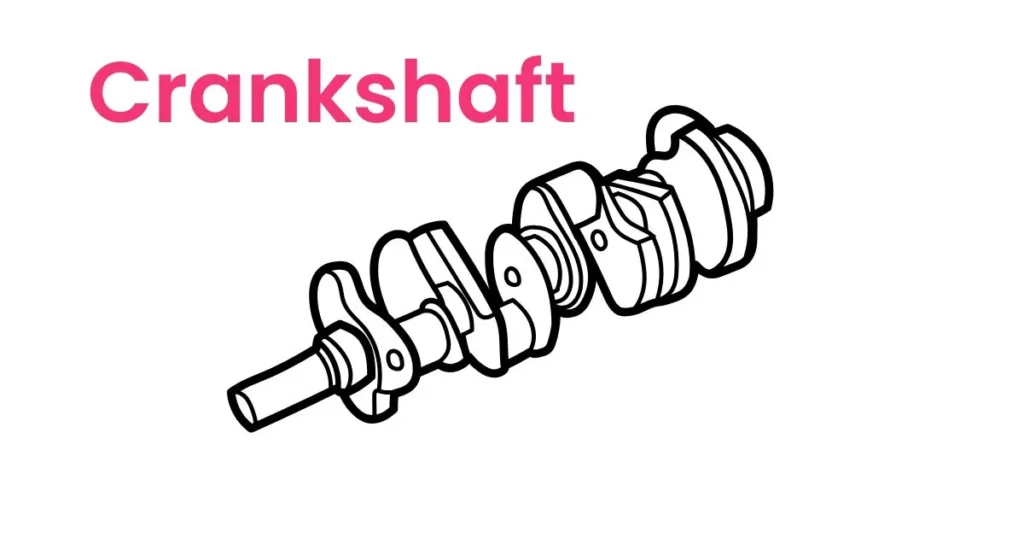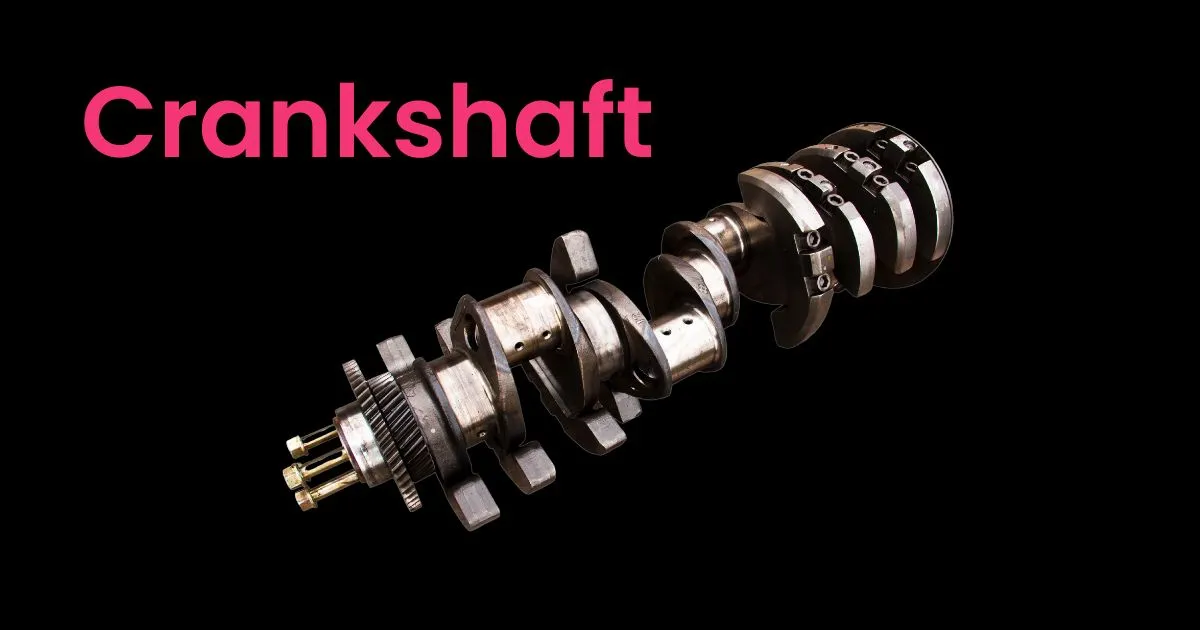The crankshaft is one of the most vital components of an engine, acting as the backbone of the internal combustion process. Without it, the engine cannot convert linear motion into rotational motion, which is required to move a vehicle.
But how exactly does a crankshaft work? What are its parts? And what happens if it fails? In this in-depth guide, we will explore everything about the crankshaft, including its functions, components, materials, working principles, and common failure symptoms.
What Is a Crankshaft?
A crankshaft is a rotating mechanical component that converts the up-and-down (reciprocating) motion of the engine’s pistons into rotational energy. This rotational energy is then transferred to the transmission, wheels, and ultimately, the movement of the vehicle.
The crankshaft plays a critical role in power generation by ensuring that the pistons move in a synchronized manner, allowing the engine to operate smoothly and efficiently.
How Does a Crankshaft Work?
The crankshaft functions as a link between the pistons and the drivetrain. Here’s how it works:
- Power from Pistons – When fuel burns inside the cylinders, the resulting combustion force pushes the pistons downward.
- Rotational Movement – The pistons are connected to the crankshaft via connecting rods. As the pistons move up and down, the crankshaft rotates.
- Torque Generation – The crankshaft transforms the linear motion into rotational energy, producing the torque needed to power the vehicle.
- Consistent Power Flow – With the help of the flywheel, the crankshaft maintains steady rotation, ensuring smooth engine operation.
The efficiency and durability of a crankshaft directly impact an engine’s performance, fuel economy, and longevity.
Parts of a Crankshaft

A crankshaft is made up of several key components, each serving a specific function. Below are the main parts of a crankshaft:
1. Crankpin
The crankpin is where the connecting rods attach to the crankshaft. It allows pistons to transfer force to the crankshaft, enabling rotation.
2. Main Journals
Main journals act as support points, allowing the crankshaft to rotate smoothly within the engine block. These journals rest on bearings, reducing friction.
3. Crank Web
The crank web connects the crankpins and main journals, providing rigidity and structural stability to the crankshaft.
4. Counterweights
Counterweights help balance the crankshaft, reducing vibrations and enhancing engine smoothness.
5. Thrust Washers
Thrust washers prevent excessive lateral movement of the crankshaft, ensuring proper alignment and reducing wear.
6. Oil Passages and Oil Seals
Oil passages allow lubrication to reach key areas of the crankshaft, preventing wear and overheating. Seals prevent oil leakage.
7. Flywheel Mounting Flange
This is where the flywheel attaches to the crankshaft, helping to maintain smooth rotation and momentum.
Each of these parts works together to ensure that the crankshaft operates efficiently, withstands high pressures, and maintains engine stability.
Construction of a Crankshaft
Crankshafts are made from high-strength materials to withstand the extreme pressures and forces inside an engine. The most common materials used are:
1. Cast Iron
- Used in lower-performance and budget-friendly engines.
- Provides adequate durability but is heavier and less resistant to wear.
2. Carbon Steel
- Offers higher strength and resistance to stress.
- Commonly used in standard passenger vehicles.
3. Vanadium Micro-Alloyed Steel
- Contains vanadium for improved durability and heat resistance.
- Used in high-performance and racing engines.
4. Forged Steel
- The strongest and most durable material, used in heavy-duty and high-horsepower engines.
- Provides exceptional resistance to fatigue and extreme loads.
Choosing the right material for a crankshaft is critical to its durability, performance, and longevity.
What Is a Crankshaft Sensor?
A crankshaft sensor, also known as a crankshaft position sensor (CKP sensor), is an electronic device that monitors the position and speed of the crankshaft. This information is sent to the engine control unit (ECU), which adjusts fuel injection and ignition timing for efficient engine operation.
Without a properly functioning crankshaft sensor, the engine may experience starting issues, misfires, or even complete failure.
Types of Crankshaft Position Sensors
Crankshaft sensors come in different types, depending on the method they use to detect crankshaft position and speed.
1. Magnetic Pickup (MPU) Type
- Uses a magnetic field and reluctor wheel to detect crankshaft movement.
- Common in older vehicles and industrial engines.
- Less accurate than modern sensors but durable and cost-effective.
2. Magneto-Resistive (MRE) Type
- Uses advanced magnetic resistance technology for precise position detection.
- Found in modern vehicles with advanced ECU systems.
- Provides higher accuracy and better performance at varying speeds.
The choice of crankshaft sensor type depends on the engine’s complexity and performance requirements.
Common Crankshaft & Crankshaft Sensor Failure Symptoms
A failing crankshaft or crankshaft sensor can cause several performance issues. Here are the most common symptoms to watch for:
1. Check Engine Light Comes On
A faulty crankshaft sensor can trigger the check engine light, indicating a problem in engine timing or rotation speed detection.
2. Engine Not Starting
If the sensor fails completely, the ECU may not receive accurate crankshaft position data, preventing the engine from starting.
3. Poor Performance
A malfunctioning crankshaft can cause engine misfires, rough idling, or hesitation during acceleration.
4. Engine Stalling
A failing sensor can cause the engine to stall unexpectedly, as the ECU loses track of crankshaft position.
5. Increased Fuel Consumption
When the ECU cannot accurately control fuel injection timing, the engine may use more fuel than necessary, reducing efficiency.
6. Inconsistent Acceleration
A faulty crankshaft sensor can disrupt ignition timing, leading to delayed throttle response or jerky acceleration.
7. Sudden Drops in RPM
An erratic crankshaft signal may cause unexpected RPM fluctuations, affecting driving smoothness.
Ignoring these warning signs can lead to engine failure or expensive repairs, so it’s crucial to address crankshaft-related issues early.
5 Functions of a Crankshaft
The crankshaft plays several critical roles in an engine’s operation. Below are its five key functions:
1. Converts Reciprocating Motion to Rotational Motion
The crankshaft transforms the up-and-down movement of the pistons into continuous rotary motion, which powers the vehicle.
2. Drives Other Engine Components
It provides rotational force to drive essential components such as:
- Camshaft (which controls valve timing)
- Timing belt or chain
- Oil pump and water pump
3. Maintains Engine Balance
The counterweights on the crankshaft help reduce vibrations, ensuring smooth operation.
4. Stores Rotational Energy
The crankshaft works with the flywheel to store and release rotational energy, preventing engine stalls.
5. Ensures Proper Engine Timing
By working with the crankshaft position sensor, the crankshaft ensures that fuel injection and spark ignition happen at the right time.
A well-functioning crankshaft is essential for an engine’s efficiency, durability, and overall performance.
How to Maintain a Crankshaft for Long Life?
Regular maintenance can extend the life of a crankshaft, preventing costly repairs and engine damage. Here are key maintenance tips:
1. Regular Oil Changes
Proper lubrication reduces friction and wear on crankshaft journals and bearings.
2. Keep an Eye on Engine Vibrations
Unusual vibrations could indicate imbalance, misalignment, or worn-out bearings.
3. Inspect for Cracks or Damage
A cracked crankshaft can cause catastrophic engine failure. Visual inspections help detect early signs of wear.
4. Monitor Oil Pressure
Low oil pressure can lead to insufficient lubrication, accelerating crankshaft wear.
5. Address Engine Misfires Immediately
Misfires create uneven forces on the crankshaft, leading to premature fatigue and failure.
By following preventative maintenance practices, a crankshaft can last for the entire lifespan of an engine.
Conclusion
The crankshaft is the central component that ensures smooth power transfer from the pistons to the drivetrain. Without it, the engine cannot generate rotational force, making the vehicle inoperable.
By understanding how it works, its key components, and how to maintain it, you can prevent engine damage, improve fuel efficiency, and ensure a longer lifespan for your vehicle.
If you notice any warning signs of crankshaft or crankshaft sensor failure, it’s crucial to address the issue early to avoid costly repairs. A well-maintained crankshaft ensures optimal engine performance and driving reliability for years to come.
FAQs
What is the primary function of a crankshaft?
A crankshaft converts reciprocating piston motion into rotational energy, which powers the vehicle’s drivetrain.
How do I know if my crankshaft is failing?
Common signs include excessive vibrations, engine misfires, poor fuel economy, and loss of power.
Can a crankshaft be repaired?
In some cases, minor crankshaft damage can be machined or polished, but severe cracks or wear require replacement.
How much does it cost to replace a crankshaft?
Crankshaft replacement can cost between $1,500 and $3,000, depending on the vehicle make and labor costs.
What happens if a crankshaft sensor fails?
A faulty crankshaft sensor can cause starting issues, engine stalling, misfires, and reduced performance.
How long does a crankshaft last?
With proper maintenance, a crankshaft can last the entire life of the engine, typically over 150,000 miles.

